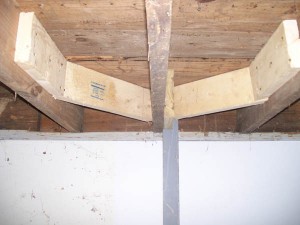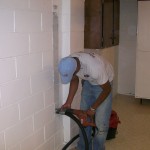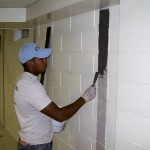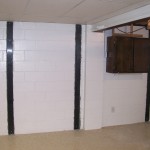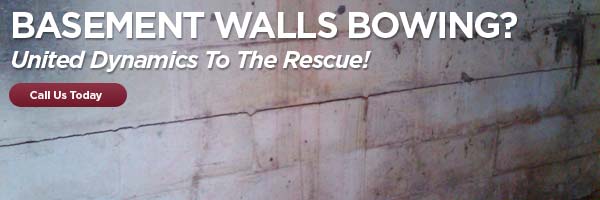
Typically, foundations are stressed when pressure is exerted on the outside of the foundation, causing walls to crack and separate beyond their tensile capacity. If not stopped or properly reinforced, the foundation could collapse. Foundation repair services can permanently fix your bowing basement walls.
Symptoms of Bowing Basement Walls:
- In block walls, a horizontal crack typically will appear approximately ½ to ¾ from the floor.
- In poured walls, diagonal cracks typically will appear from close to the corners near the floor and extending up to the top of the wall.
- If hydrostatic pressure is a contributing factor, these cracks may also be leaking.
If you’ve noticed any of these symptoms of bowing basement walls in your home, foundation repairs may be necessary.
Causes of Bowing Basement Walls:
- Hydrostatic pressure – High water tables put additional pressures on foundation walls causing leakage and structural failure.
- Expansive soils – Typical clay-based soils are susceptible to changes in moisture content. Wet conditions cause clay-based soils to expand and exert pressure on basement walls.
- Lateral earth movement – Hillside slippage, blasting or new construction can put additional pressures on foundation walls.
Cures for Bowing Basement Walls:
Abe Jack:
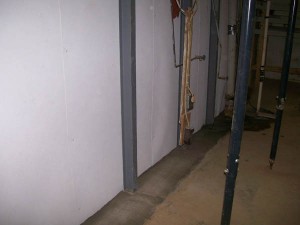 The Abe Jack system is capable of straightening and reinforcing basement walls to give the strength needed to resist earth pressure. In block or poured walls, problems can be caused by earth, hydrostatic, and frost pressure. Block wall cracks in basements usually create mid-wall bowing. The Abe Jack system provides fast and easy repair. Cracks in poured basement walls usually create top wall displacement. The Abe Jack system corrects the problem by applying pressure on the tipped area. The Abe Jack is versatile enough to slide up or down and lock to exert pressure at several points, thus making it possible to correct complex wall displacement. The Abe Jack system continues to work after the wall is straightened. The steel wall reinforcing beams provide continued support, safeguarding against potential future problems.
The Abe Jack system is capable of straightening and reinforcing basement walls to give the strength needed to resist earth pressure. In block or poured walls, problems can be caused by earth, hydrostatic, and frost pressure. Block wall cracks in basements usually create mid-wall bowing. The Abe Jack system provides fast and easy repair. Cracks in poured basement walls usually create top wall displacement. The Abe Jack system corrects the problem by applying pressure on the tipped area. The Abe Jack is versatile enough to slide up or down and lock to exert pressure at several points, thus making it possible to correct complex wall displacement. The Abe Jack system continues to work after the wall is straightened. The steel wall reinforcing beams provide continued support, safeguarding against potential future problems.
The beams are secured by steel bolts, which are bolted into the concrete floor and footing and wedged against the wall. The beam’s top is secured by bracing into the floor joists for extra strength.
Helical Tieback:
Basement walls can be repaired using helical screw anchors. This is accomplished by drilling a small hole for the anchor rod to pass through the basement wall, and then excavating a hole outside to place the bearing plate. A small high torque motor then rotates the screw anchor system into the soil. Once depth and predetermined torque is achieved, the anchor is terminated and a plate is mounted inside the basement wall to hold the wall in place. If the wall needs to be moved, then sufficient soil must be removed to allow the wall to move.
Carbon Fiber Strip:
A carbon fiber strip is a 4-inch wide repair plate bonded with structural epoxy made to stabilize basement foundation walls. When a carbon fiber strip is applied to basement foundation walls, it counteracts further outside pressure on the wall, taking the tension force (or tensile load) that the wall cannot. For every increase in pressure on the wall, the carbon fiber strip supplies an equal and opposite resistant force making the wall stronger. It helps eliminate expanding, shifting, cracking, and bowing basement walls.

